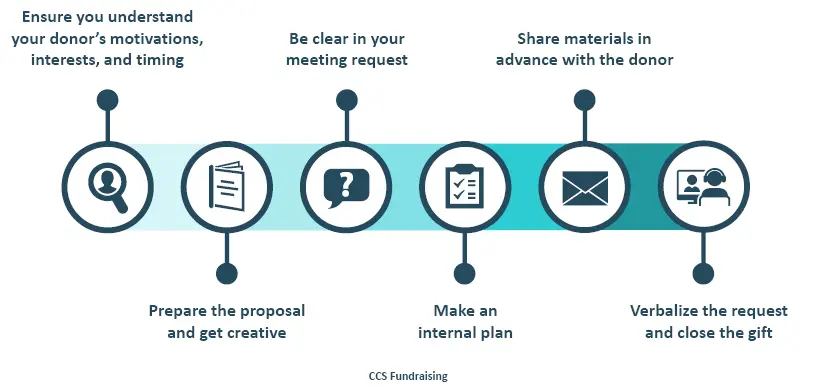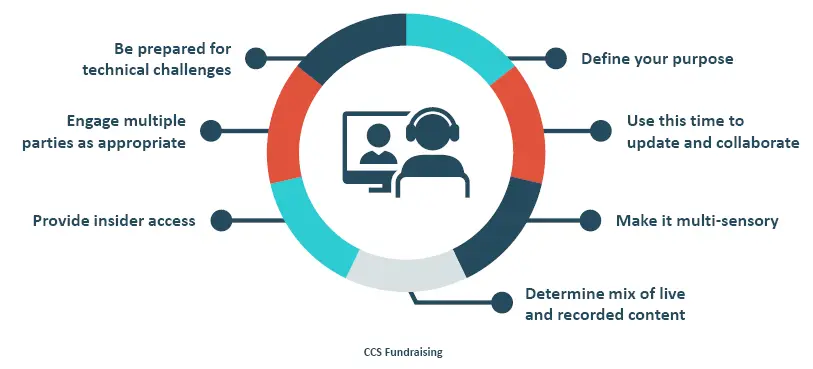In CCS’s January 2021 Philanthropic Climate Survey, more than half of respondents reported that they have held a virtual major gift solicitation through either phone, video, or both methods since the COVID-19 pandemic began. Of those who held virtual solicitations, a combined 72% of respondents reported that their virtual requests were either as successful or more successful than a typical in-person solicitation, as illustrated below.
CCS’s research encouragingly suggests that nonprofits can get the same or even better results from virtual major gift solicitations as they can from in-person solicitations. But virtual solicitations could also be more than a stopgap measure as we enter what are hopefully the final phases of the pandemic.
Virtual solicitations are convenient, cost-effective, and allow for nonprofits to secure meetings with prospects who might not normally agree to meet if travel is required. Even after it’s safe to meet in-person, donors may still prefer to keep virtual meetings as an option.
Regardless of whether you’ve conducted many virtual major gift solicitations or you’re just getting started, perfecting your approach will pay off not just for the duration of the pandemic—it will likely yield dividends in a post-pandemic world as well.
Key Steps for Success

Regardless if you are face-to-face with a donor in-person or via video, tried and true major gift fundraising best practices still apply. The preparation and strategy required for these virtual donor meetings are crucial to ensure you use your time wisely. It is important to realize that Zoom fatigue is real not only for frontline fundraisers, but also for our donors as well.
Make sure to take a step back, reflect, and assess what you hope to get out of your time with each donor. For example, meetings that don’t require you to walk through a proposal or presentation might be better accomplished through a one-on-one phone call.
As you look to engage your major donors in a virtual solicitation meeting, consider these key steps:
1. Ensure you understand your donor’s motivations, interests, and timing
As you would in any donor relationship, you must cultivate and build a foundation based on what the donor cares about, the impact they hope to make, and how their interests align with the organization’s funding needs and priorities. It is important that you are on the same page with the donor, confirming that now is the right time to make a request and they are ready to make an investment. The key question to answer is, “have you requested permission to ask?” If not, be sure to take this step before initiating or drafting a proposal for consideration. There shouldn’t be any surprises going into your virtual solicitation meeting.
2. Prepare the proposal and get creative
Just like you would in preparing for an in-person solicitation meeting, make sure you have a thorough yet concise proposal to share with your prospective donor. Ensure the proposal conveys the need, meets the donor’s interests, provides a clear investment opportunity, and identifies the impact the donor can have through their support. Since the proposal will be shared in a virtual setting, consider if a video or a participant testimonial would convey the need in a more impactful manner than a traditional written narrative. Consider what other aspects of the proposal can be brought to life through other media during your virtual conversation.
3. Be clear in your meeting request: virtual “face-to-face” meeting
When reaching out to the donor, be clear that you would like to meet face-to-face over a video platform of their choosing, giving you the opportunity to share more detailed information and walk-through the proposal. This meeting should be at least 45 minutes long, giving enough time to review the proposal and answer questions. If the donor prefers a phone call, still take them up on this offer to keep the door open to a conversation.
4. Make an internal plan
If there are many members of your team engaged in this virtual solicitation, it is important to discuss the following:
- Determine the flow of the meeting and focused goals: What do you hope to accomplish? What three ideas do you hope to convey? How can you ensure you are engaging the donor in a discussion rather than simply presenting?
- Establish roles and objectives: Who is sharing what information? Who will be sharing their screen during the proposal walk-through? Who will be making the ask? Who is in command of the meeting to ensure the conversation keeps moving?
- Draft an internal agenda: Since everyone will be attending the meeting from different locations, it is important to write out as much of the meeting flow of ideas and topics to discuss in advance to ensure everyone is on the same page. It is difficult to read body language or know who is preparing to speak in a virtual setting.
- Develop the presentation deck/proposal: Determine who is responsible for pulling together the presentation deck or other interactive media to include. The slide deck does not need to be the proposal. It can call attention to the need, key funding areas, the partnership opportunity, the overall impact, and the stewardship/recognition the donor would receive. Include videos and photos where possible, while limiting the amount of copy per slide.
- Practice: Schedule a time to prep with your internal team to practice sharing your screen, any key talking points, and other logistics before meeting with the donor. Use this time to practice out loud the formal gift request.
5. Share materials in advance with the donor
You never know what to expect with technology and will want to maximize your time with the donor. Plan to share the proposal and any other supporting documents that will be discussed during your virtual meeting in advance of your scheduled time together. That way, the donor can pull up the documents if needed or review them in advance and come to the table with any immediate questions. To note: when sharing these materials in advance, be sure to let the donor know that your time together will be walking through the concept shared.
6. Verbalize the request and close the gift
When connecting with your donor via video, consider when is the right time is to share your screen and at what points during the discussion it is most helpful to just have a conversation face-to-face.
Potential Format:
- Welcome and check-in
- Thank the donor for meeting
- Transition to the proposal (share your screen)
- Convey the need
- Outline the investment opportunity
- Share the impact this investment will have on the organization and the community it serves
- Be sure to verbalize the request and pause for a response
- Discuss recognition opportunities, if appropriate
- Answer any outstanding questions
- Set next steps
Post-Meeting: Send the donor a follow-up thank you email the same day to close the gift. Be sure to outline any agreed-upon next steps, the amount they agreed to give, their areas of support, and over what period of time.
Virtual Engagement Best Practices

Whether you are looking to engage your donors in a virtual cultivation or solicitation meeting, consider the following best practices:
- Define your purpose: what do you hope the donor will get out of this meeting?
- Use this time to update and collaborate: engage the prospect in conversation by posing questions or include an interactive feature
- Make it multi-sensory: lead with visuals and include minimal text
- Determine what content needs to be live and what can be prerecorded
- Provide insider access and make it feel exclusive and customized
- Engage board members and key volunteers in the discussion, as appropriate
- Be prepared for technical challenges: designate one person to screen share, practice in advance, and use Zoom as it is the most universal platform for donors
Final Thoughts
As nonprofit leaders continue to adapt and navigate the social distancing restrictions and the various shifts in fundraising activity, we identify new, creative ways to meet yearly fundraising goals. With the continued focus on building and maintaining relationships with current and potential donors amid a pandemic, nonprofits have found new ways to stay connected, tell their story, convey the need, and still receive transformational investments either over the phone or via video call.
There is no better time than now to embrace the virtual tools available to continue to engage and build relationships with current and future donors. Remember, many donors are already comfortable with various video platforms as they have used this as their main source of contact with family and friends over the last year.
At the end of the day, your virtual donor meetings and in-person donor meetings serve the same purposes: an opportunity to learn donors’ interests, build rapport, and bring them closer to your organization. Using a combination of tried-and-true best practices and a recognition of the opportunities and challenges inherent in a virtual setting, virtual major gift solicitations can help your organization secure transformational gifts in an era of social distancing—and maybe even beyond.